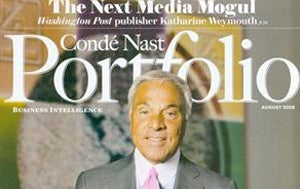Portfolio, the $125m 'Vogue for the business set', folds in face of slump

Your support helps us to tell the story
From reproductive rights to climate change to Big Tech, The Independent is on the ground when the story is developing. Whether it's investigating the financials of Elon Musk's pro-Trump PAC or producing our latest documentary, 'The A Word', which shines a light on the American women fighting for reproductive rights, we know how important it is to parse out the facts from the messaging.
At such a critical moment in US history, we need reporters on the ground. Your donation allows us to keep sending journalists to speak to both sides of the story.
The Independent is trusted by Americans across the entire political spectrum. And unlike many other quality news outlets, we choose not to lock Americans out of our reporting and analysis with paywalls. We believe quality journalism should be available to everyone, paid for by those who can afford it.
Your support makes all the difference.It was meant to be Vanity Fair or Vogue for the international business set, a chunky monthly tome crammed to its glossy gills with ads for expensive watches, private jets and second or third homes. But, with the international business elite on their knees, amid the wreckage of the credit crisis, it is closing time too for Portfolio magazine, launched just two years ago by luxury publishers Condé Nast.
The magazine's 85 staff were told yesterday that there would be no more publications, that the lavish budget – promised two years ago and whittled down like the stock market ever since – had run out, and the company could sustain no more losses.
Its spectacular arc, from glitzy launch to grisly demise, mirrors exactly that of the businessfolk it was aimed at, the Masters of the Universe on Wall Street and the world of hedge funds who were raking in seven-, eight- or nine-figure bonuses as their industry revelled in the boom of cheap credit.
It was a natural group for Condé Nast to want to lure. With Vogue, the company was publishing the official bible of the high fashion world; Vanity Fair was on the coffee table of all at the pinnacle of high society. By courting the new elite of high finance, it would complete a powerful triumvirate.
Si Newhouse lured Joanne Lipman from The Wall Street Journal to edit the thing, and she was given a reported $125m budget that made Portfolio the most costly magazine launch ever. At the Journal, she had created a lifestyle section that stood out from the rest of the staid newspaper as much for its massive haul in ad revenue as for its colour and glamour.
Portfolio launched with a long essay on the new Masters of the Universe by Tom Wolfe, author of Bonfire of the Vanities, the quintessential novel of the Eighties' Wall Street boom, and it continued to offer big-name interviews and insights into swanky lifestyles. Yet it never fully stood out from slightly inkier rivals, such as BusinessWeek and Forbes. And as the bottom fell out of the credit markets there began to be something slightly unseemly about a glossy business magazine.
More importantly, advertisers were cutting back and so were the executives, hedge fund stars and entrepreneurs that Portfolio liked to think of as its natural readership. Circulation for the second half of last year was 449,005, but many copies were being given away. By last October, the magazine cut publication from 12 to 10 issues a year and Condé Nast gutted staffing of the vastly expensive Portfolio.com.
Those who remained thought that had at least bought them until the second half of this year but ad pages in Portfolio declined 46 per cent in the first three months of 2009, compared to 26 for the rest of the industry.
"While the unprecedented nature of these times has made business and the economy the main topic of conversation, it has also led to high levels of uncertainty and a tremendous reduction in ad spend in sectors Portfolio depends on," David Carey, group publisher of the titles that include Portfolio, in an email to staff.
For the myriad critics who chimed in during the launch, yesterday's closure is sweet schadenfreude.
For Condé Nast, the debacle comes on the Jimmy Choo heels of the closure of its chic lifestyle title Domino and the axing of the German Vanity Fair. Like the billionaire set it was courting, those at the top of the publishing food chain are having to watch the pennies too.
Executive crisis Luxury casualties
*The private jet manufacturer Cessna laid off 2,800 workers last week. Hoping to rekindle the macho executive market, a recent ad read: "Timidity didn't get you this far. True visionaries will continue to fly."
*The Leading Hotels Of The World now lead by less: their members had 10 per cent fewer bookings last year. With a quarter of business coming from corporate clients, the future looks grim.
*LVMH, owners of the handbag and champagne brands Louis Vuitton and Dom Perignon, suffered a nasty seven per cent drop in sales in the last quarter. "There is not much to celebrate these days so the demand is not that great," an executive ruefully explained.
Join our commenting forum
Join thought-provoking conversations, follow other Independent readers and see their replies
Comments